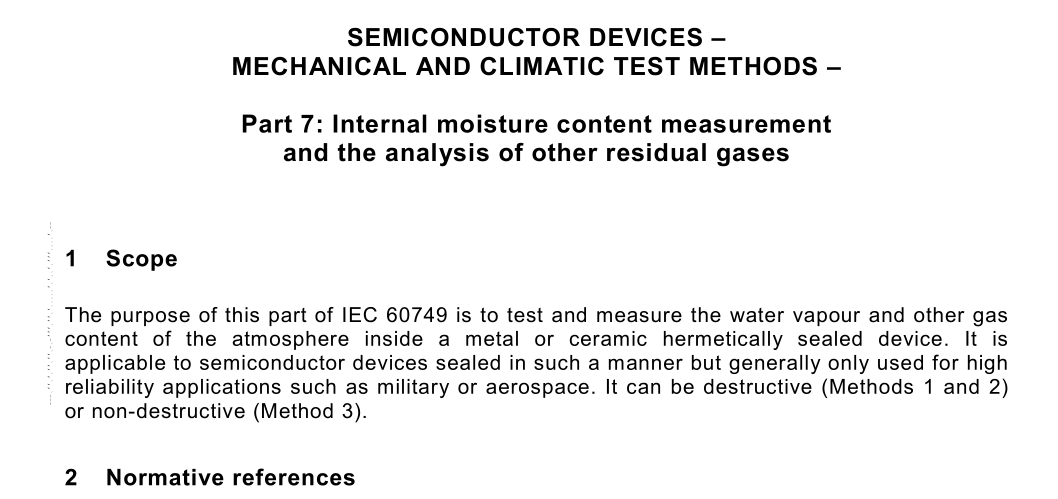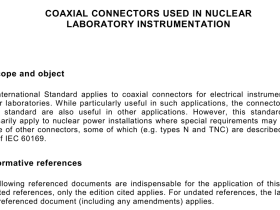IEC 60749-7:2002 pdf download

IEC 60749-7:2002 pdf download.SEMICONDUCTOR DEVICES – MECHANICAL AND CLIMATIC TEST METHODS – Part 7: Internal moisture content measurement and the analysis of other residual gases
1 Scope
The purpose of this part of IEC 60749 is to test and measure the water vapour and other gas content of the atmosphere inside a metal or ceramic hermetically sealed device. It is applicable to semiconductor devices sealed in such a manner but generally only used for high reliability applications such as military or aerospace. It can be destructive (Methods 1 and 2) or non-destructive (Method 3).
2 Normative references
The following referenced documents are indispensable for the application of this document. For dated references, only the edition cited applies. For undated references, the latest edition of the referenced document (including any amendments) applies. IEC 60749-8, Semiconductor devices – Mechanical and climatic test methods – Part 8: Sealing 1)
3 Test apparatus
The apparatus for testing the internal water vapour content and that of other gases shall be as follows for the chosen method. 3.1 Method 1 Method 1 measures the water vapour content of the device atmosphere by mass spectro- metry. The apparatus for method 1 shall consist of: a) A mass spectrometer capable of reproducibly detecting the specified moisture content for a given volume package with a factor of ten sensitivity safety margin (i.e. for a specified limit of 5 000 × 10 – 6 by volume 2) , 0,01 ml, the mass spectrometer shall demonstrate a 500 × 10 –6 by volume or less absolute sensitivity to moisture for a package volume of 0,01 ml). The smallest volume shall be considered the worst case. The calibration of the mass spectrometer shall be accomplished at the specified moisture limit (±20 %) using a package simulator which has the capability of generating at least three known volumes of gas ±10 % on a repetitive basis by means of a continuous sample volume purge of known moisture content ±10 %. Moisture content shall be established by the standard generation techniques (i.e. double pressure, divided flow, or cryogenic method). The absolute moisture shall be measured by a moisture dew point analyzer. A vacuum opening chamber which can contain the device and a vacuum transfer passage connecting the device to the mass spectrometer of 3.1a). The transfer passage shall be maintained at 125 °C ± 5 °C. The fixturing in the vacuum opening chamber shall position the specimen as required by the piercing arrangement of 3.1c) and maintain the device at 100 °C ± 5 °C for a minimum of 10 min prior to piercing. c) A piercing arrangement functioning within the opening chamber or transfer passage of 3.1b), which can pierce the specimen housing (without breaking the mass spectrometer chamber vacuum and without disturbing the package sealing medium), thus allowing the specimen internal gases to escape into the chamber and mass spectrometer. NOTE A sharp-pointed piercing tool, actuated from outside the chamber wall via a bellows to permit movement, should be used to pierce both metal and ceramic packages. For ceramic packages, the package lid or cover should be locally thinned by abrasion to facilitate localized piercing but care should be taken to ensure that the package remains hermetic.
3.2 Method 2
Method 2 measures the water vapour content of the device atmosphere by integrating moisture picked up by a dry carrier gas at 50 °C. The apparatus for Method 2 shall consist of: a) An integrating electronic detector and moisture sensor capable of reproducibly detecting a water vapour content of 300 × 10 –6 ± 50 × 10 –6 by volume moisture for the package volume being tested. This shall be determined by dividing the absolute sensitivity in micrograms H 2 O by the computed weight of the gas in the device under test, and then correcting to parts per million by volume (ppmv). b) A piercing chamber or enclosure, connected to the integrating detector of 3.2a), which will contain the device specimen and maintain its temperature at 100 °C ± 5 °C during measurements. The chamber shall position the specimen as required by the piercing arrangement. The piercing mechanism shall open the package in a manner which will allow the contained gas to be purged out by the carrier gas or removed by evacuation. The sensor and connection to the piercing chamber will be maintained at a temperature of 50 °C ± 2 °C.









